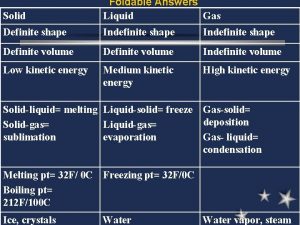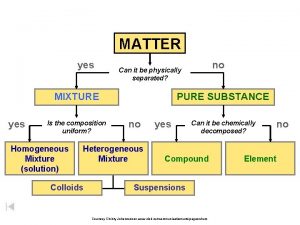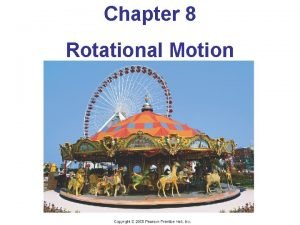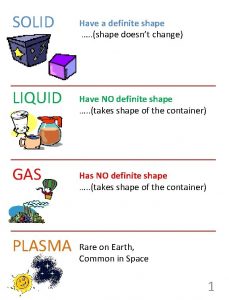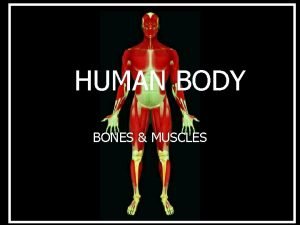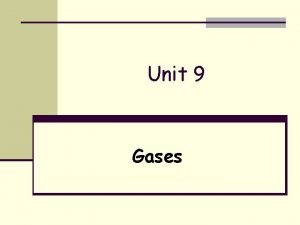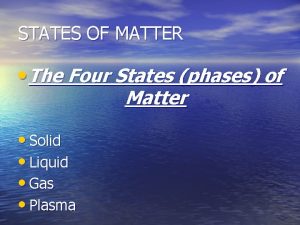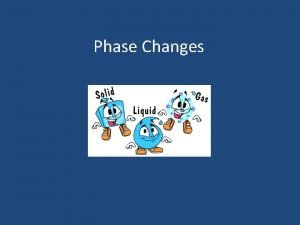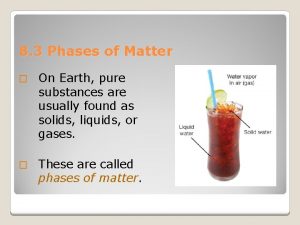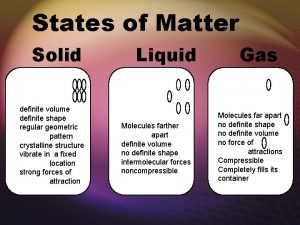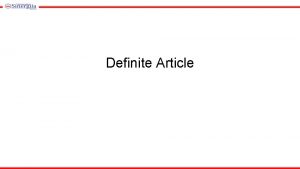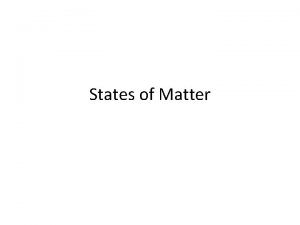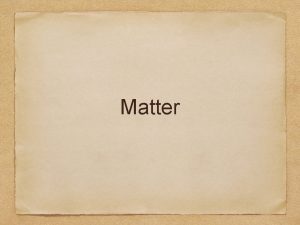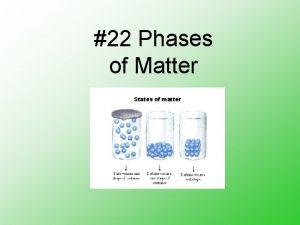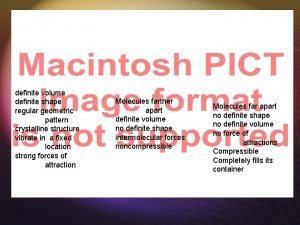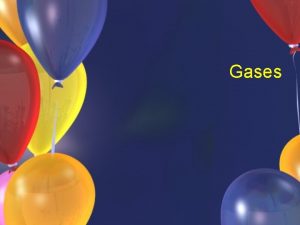Phases of Matter Phases Review Solid Definite shape
















- Slides: 16

Phases of Matter

Phases Review • Solid – Definite shape & volume • Liquid – Definite volume but can change shape (depends on container) • Gas – No definite shape or volume • Plasma – Ionized gas

• As an object changes phase, the number of atoms does not change just their arrangement.

Temperature • Temperature is the amount of kinetic energy (KE) an object has – The greater the temperature, the more KE, the more the atoms move – All molecules move if their temperature is above 0 K (absolute zero)

• Objects at the same temperature have the same KE • even though objects have different properties they have same KE at the same temperature.

• If all molecules have the same kinetic energy at the same temperature, why don’t all things have the same melting and boiling points? – Different molecules have different intermolecular forces acting on them • Stronger the intermolecular force, the higher the melting and boiling points

• The more KE an object has, the faster the molecules will move (creating disorder). • Entropy = disorder • As temperature increases, entropy increases. • Amount of entropy Solid < liquid < gas < plasma


Kinetic Theory of Gases • Gas molecules are in constant, rapid, straight line motion – (have high temperatures, therefore high amounts of KE)

Kinetic Theory of Liquids • When the temperature decreases, kinetic energy decreases. – Molecules move slower. – Molecules slow down enough that molecules are attracted to each other enough to overcome having random, straight line motion – causes molecules to become liquids (molecules can still slide past each other. )

Kinetic Theory of Solids • As molecules in a liquid cool, they move more slowly. – Eventually, temperature is reached at which molecules take a fixed position in a regular geometric pattern – Molecules are held at fixed positions by strong intermolecular forces

Melting • As temperature increase, molecules vibrate faster and farther apart until the strong intermolecular forces are overcome enough for the molecules to glide past each other • Melting = endothermic.

Changes of Phase terms • • • Freezing: liquid solid Melting: solid liquid Condensation: gas liquid Evaporation: liquid gas Sublimation: solid gas Deposition: gas solid

Phase Change Diagram


Solutions • Solutes impact boiling and melting points – Boiling point is raised when solutes are present • Presence of solutes makes it difficult for water to become a gas – Freezing point is depressed (lowered) • When solute is present in solvent, harder for solvent molecules to make crystal like structure
 Solid definite or indefinite
Solid definite or indefinite Uniform composition
Uniform composition A body with a definite shape that doesn't change is
A body with a definite shape that doesn't change is Definite volume
Definite volume Gliding joint
Gliding joint Having no definite shape
Having no definite shape Four phases of matter
Four phases of matter Four states of matter
Four states of matter Phases changes of matter
Phases changes of matter 3 phases of matter
3 phases of matter Why isn't it a good idea to classify matter by its phases
Why isn't it a good idea to classify matter by its phases Whats the study of matter and energy
Whats the study of matter and energy Phases of matter
Phases of matter Concept map matter
Concept map matter Crystalline or amorphous
Crystalline or amorphous Solid
Solid Covalent network solid vs molecular solid
Covalent network solid vs molecular solid
